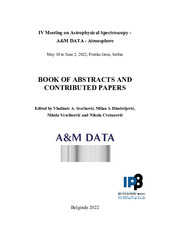| dc.description.abstract | Solar radiation has the most significant influence on photo-ionization in the
Earth's ionosphere, and different parts of its spectrum in the UV and X domains
have a dominant role in producing free electrons at different ionospheric heights. In
calm conditions, the dominant role in photo-ionization processes in the D-region
has the hydrogen Lyα line, while in the higher layers, the ionosphere is primarily
ionized by photons from the X spectrum.
Through ionization processes, solar radiation significantly affects changes in the
electron density in the ionosphere and, consequently, the propagation of
electromagnetic (EM) waves in this atmospheric layer. One of the most significant
EM waves propagating in the ionosphere is Global Navigation Satellite Systems
(GNSS) signals with various applications, including navigation and positioning
applications. Since 1987 International Association of Geodesy (IAG), as one of the
several associations of the International Union of Geodesy and Geophysics
(IUGG), has been responsible for establishing and maintaining European
Terrestrial Reference System (ETRS). To establish and maintain ETRS, IAG has
formed a special commission entitled EUREF (European Reference Frame),
responsible for creating and maintaining the EUREF Permanent Network (EPN) as
a science-driven network of continuously operating GNSS reference stations. More
than 100 European agencies and universities are voluntarily involved in the EPN,
with 368 stations all over Europe. In general, all GNSS stations continuously
receive the data from all currently available GNSS: American NavStar, Russian
GLONASS, Chines BeiDou, and European Galileo systems. The received data are
stored in EPN Data Centres (DC), and all data are publicly available in several
RINEX formats (Receiver Independent Exchange Format). Besides data centers,
EUREF organized EPN Analysis Centers (AC) to provide products such as the
EPN GNSS station positions and velocities, EPN zenith tropospheric path delay
estimates, and ETRS89 satellite orbit and correction streams.
In the precise positioning process, the crucial element is modeling the
ionosphere, which gives significance for practical applications to studies that
analyze the influence of solar radiation and its spectrum on photo-ionization
processes. Namely, the ionosphere delays EM waves that pass to it and induces a
37
IV Meeting on Astrophysical Spectroscopy - A&M DATA - Atmosphere
BOOK OF ABSTRACTS AND CONTRIBUTED PAPERS
Eds. V. A. Srećković, M. S. Dimitrijević, N. Veselinović and N. Cvetanović
delay of propagation related to the electronic density (Total Electron Content -
TEC) and the wave frequency. This delay is directly proportional to the TEC and
inversely proportional to the square of the carrier frequency. Those effects can
produce an error in points coordinates from 3 to 15 m. Besides this effect, there are
also effects caused by irregularities in the ionosphere – scintillation effects – which
can cause a large number of cycle slips in GNSS signals. The magnitude of
mentioned errors is the main reason for many studies and papers dedicated to
modeling ionospheric effects on GNSS and using GNSS signals to determine
global, regional, and local ionospheric models.
It is usual in GNSS applications to split the determination of ionosphere into
deterministic and stochastic parts. The deterministic part is dedicated to creating
models of the ionosphere, and the stochastic part is dedicated to the determination
of short-term TEC variation throughout the estimation of Stochastic Ionosphere
Parameters (SIP). This paper is dedicated to determining the deterministic part by
modeling local, regional, and station-specific ionosphere models. All mentioned
models are created based on available EPN data by Bernese GNSS Software
Version 5.2 and mentioned models are represented by Taylor series expansion in
the case of local models and spherical harmonic expansion for the regional and
station-specific models. All models can be produced for the desired period and, in
such a way, create relevant scientific data for studying the effect in the ionosphere
induced by changes in solar radiation | sr |

